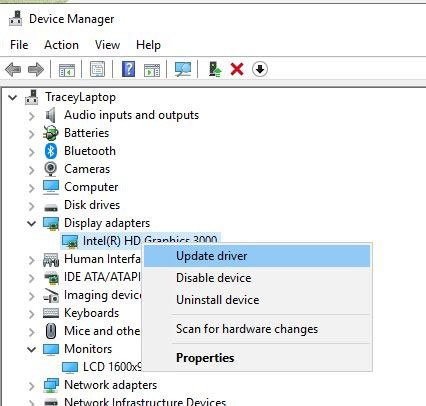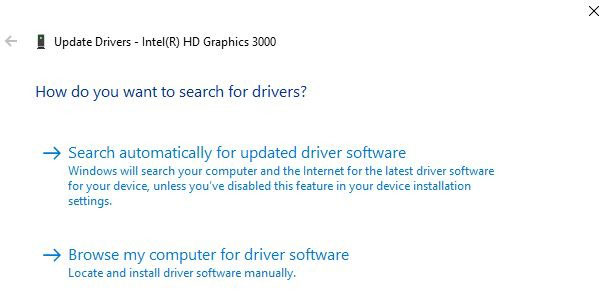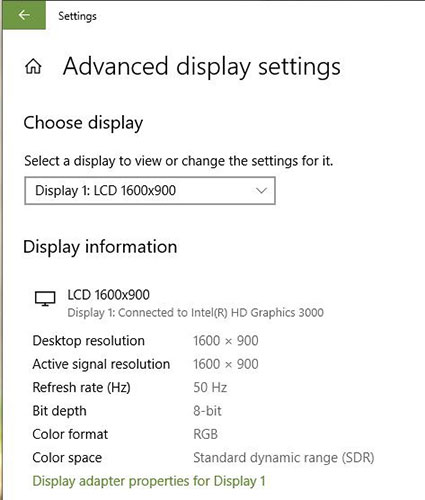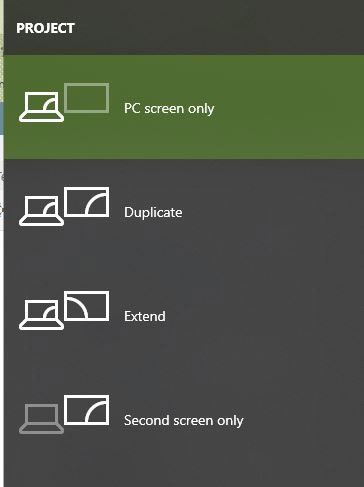How to fix problems with multi-monitor setup in Windows
Setting up a dual-screen system is useful for users for a variety of reasons, including the ability to multitask or switch between apps or websites, without minimizing the size of the window. continuity. There may be times when you are faced with problems related to the second screen. Here are some tips you can use to fix the problem.
No signal
If the second screen receives the message 'No signal' , then that means the data is not transferred from the computer to the screen. There are several different methods you can try to fix this error.
If you connect the monitor while turned on, the system may not recognize it. Turn off the monitor and then turn it back on to see if the system recognizes the new screen.
Another easy thing to check again is the cables. Make sure they are connected correctly and none of them are loose or fall out. If the cables are fine, unplug them and then plug them in again to make sure they are securely attached. You may also need to try a new cable.
Try the Windows detection tool to see why Windows doesn't recognize that a monitor is connected.
To check this, do the following:
1. Right-click on the desktop and select Display settings.

2. Scroll down until you find the Multiple display section .

3. Click the Detect button .
If the second screen has multiple input options, make sure you have pressed the button to select that type of input.
If you use a dedicated graphics card with multiple outputs, change the graphics port you are using. The port may be damaged and switching ports will fix the problem.
Although Windows 10 supports multiple monitors by default, you can try updating your graphics driver.
1. In the search box on the taskbar, type Device Manager, then select it.
2. Click the arrow next to Display adapters. Right-click on the graphics card you want to update.

3. Select Search automatically for updated driver software .

4. Select 'Update Driver'.
5. If Windows doesn't find new drivers, you can try searching the manufacturer's website.
Wrong resolution
If you are adding a new, higher-resolution monitor to your system, the new monitor may try to copy settings from the old monitor or match the settings of the current monitor. Fix the resolution of the new screen by following these steps.
1. Right-click on the screen and select Display settings from the menu.
2. Click the screen you want to edit in the top window.
3. Scroll down and find Scale and layout.
4. Under the resolution, use the drop-down menu to select the correct resolution for the screen.
If this doesn't work, try updating the graphics driver as described above.
The refresh rate is incorrect
Windows usually doesn't choose the best setting for the new monitor, so you may have to manually set a refresh rate to speed up the screen.
To test the refresh rate that the new monitor is using, try using TestUFO. Then compare that rate to the fastest speed for your new screen. If you want to change the speed, follow these steps.
1. Right-click on the desktop and select Display settings from the menu.
2. Scroll to the bottom of the window and click Advanced display setting.
3. Click Display adapter properties for X. Make sure it is the screen you want to change.

4. Select the Monitor tab at the top.
5. In the Monitor settings section , use the drop-down box to select the refresh rate you want to use.
Screen type
When adding a second monitor to your system, you can choose to expand the desktop, duplicate it or keep the desktop on just one screen. To change this setting, do the following:
1. Press Win + P
2. Select the screen you want.

The screen when playing games is reduced to the maximum size
Another problem you may encounter when using the second monitor is that the game you are playing on one screen is reduced to its maximum size for no apparent reason. You may accidentally click on the second screen because there is nothing separating the screens.
If this happens to you, try one of the following troubleshooting tips:
- Check out the options displayed in the game itself. If you're playing in 'Windowed' mode , try switching to 'Full Screen' mode instead.
- Try switching to 'Borderless Window' mode. This mode will not prevent you from moving the mouse to the other screen, but it will prevent the screen from being reduced to the maximum size when you are playing the game.
- Try the Dual Monitor Tool (reference link: http://dualmonitortool.sourceforge.net/ ). The Cursor tool allows you to lock the mouse pointer on one of the screens. Remember to unlock when you finish the game!
- Turn off the second screen or press
Win+Pto change the screen only to the desktop.
Use these tips to make using a second monitor an experience that makes you more satisfied and reduces problems that prevent you from completing a task.
Hope you are succesful.
You should read it
- How to fix common Windows 10 problems with WinDBG
- Troubleshoot problems with Avast Free Antivirus in Windows 10
- Summary of some ways to fix black screen of Windows 10
- How to move games from one screen to another in Windows
- Ways to troubleshoot audio on Windows 10
- How to fix Windows 10 hangs on the Welcome screen
- 20 useful troubleshooting tools for Windows 10
- Dell introduces new Studio series, multi-touch screen
May be interested
- How to Correct Monitor Flicker in Windows 8
 computer monitors can experience many problems, such as screens that flicker, pulsate, or randomly dim and brighten. and while it may not seem like a big deal, over time this can strain your eyes and cause headaches. monitor flicker is...
computer monitors can experience many problems, such as screens that flicker, pulsate, or randomly dim and brighten. and while it may not seem like a big deal, over time this can strain your eyes and cause headaches. monitor flicker is... - How to set up different wallpaper images on each Windows 10/11 screen
 setting up multiple monitors on windows is quite simple and only takes a few minutes to do. once you have set up multi-monitor mode (multiple monitors), you can set up individual wallpapers for each monitor. to do this, please refer to the article below from network administrator.
setting up multiple monitors on windows is quite simple and only takes a few minutes to do. once you have set up multi-monitor mode (multiple monitors), you can set up individual wallpapers for each monitor. to do this, please refer to the article below from network administrator. - How to debug a Windows application with Process Monitor
 one way to get around the problem is to use a free official microsoft utility called process monitor. this tool will help you diagnose and debug any windows application errors or problems.
one way to get around the problem is to use a free official microsoft utility called process monitor. this tool will help you diagnose and debug any windows application errors or problems. - Steps to initially set up a new SSD on Windows 10
 before you start using an ssd as secondary storage, you need to initialize it correctly. failure to do so may result in the operating system failing to detect the ssd.
before you start using an ssd as secondary storage, you need to initialize it correctly. failure to do so may result in the operating system failing to detect the ssd. - 5 ways to open Resource Monitor in Windows 10
 resource monitor is a tool that allows you to simply monitor cpu, memory, disk and network usage. in this tutorial, tipsmake will show you quick ways to open resource monitor in windows 10.
resource monitor is a tool that allows you to simply monitor cpu, memory, disk and network usage. in this tutorial, tipsmake will show you quick ways to open resource monitor in windows 10. - 11 ways to start the Performance Monitor performance monitor in Windows
 performance monitor is a sophisticated tool that can be used to monitor the performance of your windows computer or device.
performance monitor is a sophisticated tool that can be used to monitor the performance of your windows computer or device. - How to use Windows Reliability Monitor to check Windows health
 if your windows computer suddenly shuts down or applications keep crashing, you can use the windows reliability monitor tool. this is a testing tool, a diagnostic tool to see if there are any problems with your windows computer.
if your windows computer suddenly shuts down or applications keep crashing, you can use the windows reliability monitor tool. this is a testing tool, a diagnostic tool to see if there are any problems with your windows computer. - How to set up VS Code with WSL 2 on Windows 10/11
 windows subsystem for linux is powerful, but if you integrate visual studio code on your windows pc with wsl's kernel, you can do a lot in less time and in a better way.
windows subsystem for linux is powerful, but if you integrate visual studio code on your windows pc with wsl's kernel, you can do a lot in less time and in a better way. - How to work with Performance Monitor performance monitor in Windows
 have you ever heard about performance monitor or perfmon.exe or perfmon.msc in windows?
have you ever heard about performance monitor or perfmon.exe or perfmon.msc in windows? - How to initial setup Windows Server 2019
 after downloading and installing windows server 2019, you will go to the initial setup process. let's find out details through the following article!
after downloading and installing windows server 2019, you will go to the initial setup process. let's find out details through the following article!










 How to fix LogiLDA.dll error message in Windows
How to fix LogiLDA.dll error message in Windows Learn about error code 0xc0000001
Learn about error code 0xc0000001 How to repair and recover corrupted CD and DVD data
How to repair and recover corrupted CD and DVD data How to scan a hard drive with Error Checking
How to scan a hard drive with Error Checking How to fix error 0x80071ac3
How to fix error 0x80071ac3 What is Windows 8024402c update error? How to fix 8024402c error?
What is Windows 8024402c update error? How to fix 8024402c error?